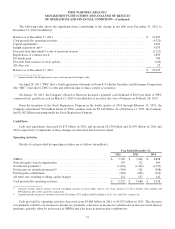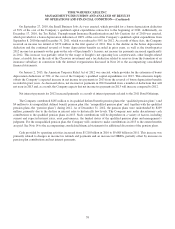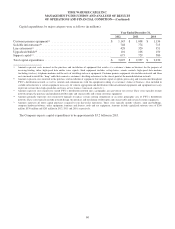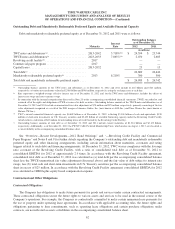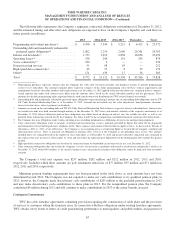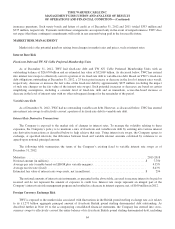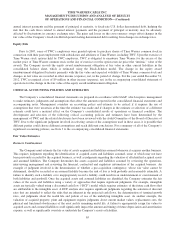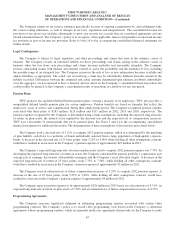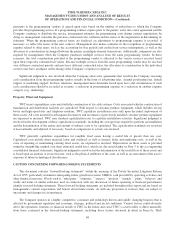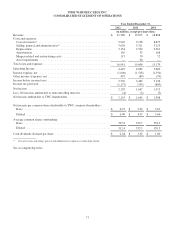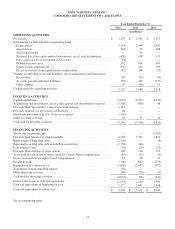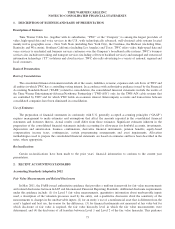Time Warner Cable 2012 Annual Report Download - page 75
Download and view the complete annual report
Please find page 75 of the 2012 Time Warner Cable annual report below. You can navigate through the pages in the report by either clicking on the pages listed below, or by using the keyword search tool below to find specific information within the annual report.TIME WARNER CABLE INC.
MANAGEMENT’S DISCUSSION AND ANALYSIS OF RESULTS
OF OPERATIONS AND FINANCIAL CONDITION—(Continued)
annual interest payments and the payment of principal at maturity, to fixed-rate U.S. dollar denominated debt, hedging the
risk that the cash flows related to annual interest payments and the payment of principal at maturity may be adversely
affected by fluctuations in currency exchange rates. The gains and losses on the cross-currency swaps offset changes in the
fair value of the Company’s fixed-rate British pound sterling denominated debt resulting from changes in exchange rates.
Equity Risk
Prior to 2007, some of TWC’s employees were granted options to purchase shares of Time Warner common stock in
connection with their past employment with subsidiaries and affiliates of Time Warner, including TWC. Upon the exercise of
Time Warner stock options held by TWC employees, TWC is obligated to reimburse Time Warner for the excess of the
market price of Time Warner common stock on the day of exercise over the option exercise price (the “intrinsic” value of the
award). The Company records the equity award reimbursement obligation at fair value in other current liabilities in the
consolidated balance sheet, which is estimated using the Black-Scholes model. The change in the equity award
reimbursement obligation fluctuates primarily with the fair value and expected volatility of Time Warner common stock and
changes in fair value are recorded in other income (expense), net, in the period of change. For the year ended December 31,
2012, TWC recognized a loss of $9 million in other income (expense), net, in the accompanying consolidated statement of
operations for the change in the fair value of the equity award reimbursement obligation.
CRITICAL ACCOUNTING POLICIES AND ESTIMATES
The Company’s consolidated financial statements are prepared in accordance with GAAP, which requires management
to make estimates, judgments and assumptions that affect the amounts reported in the consolidated financial statements and
accompanying notes. Management considers an accounting policy and estimate to be critical if it requires the use of
assumptions that were uncertain at the time the estimate was made and if changes in the estimate or selection of a different
estimate could have a material effect on the Company’s consolidated results of operations or financial condition. The
development and selection of the following critical accounting policies and estimates have been determined by the
management of TWC and the related disclosures have been reviewed with the Audit Committee of the Board of Directors of
TWC. Due to the significant judgment involved in selecting certain of the assumptions used in these areas, it is possible that
different parties could choose different assumptions and reach different conclusions. For a summary of all of the Company’s
significant accounting policies, see Note 3 to the accompanying consolidated financial statements.
Fair Value Estimates
Business Combinations
The Company must estimate the fair value of assets acquired and liabilities assumed whenever it acquires another business.
This requires judgments regarding the identification of acquired assets and liabilities assumed, some of which may not have
been previously recorded by the acquired business, as well as judgments regarding the valuation of all identified acquired assets
and assumed liabilities. The Company determines the assets acquired and liabilities assumed by reviewing the operations,
interviewing management and reviewing the financial, contractual and regulatory information of the acquired business. An
example of judgment involved is the determination of whether a pre-acquisition contingency, whose fair value cannot be
determined, should be recorded as an assumed liability because the risk of loss is both probable and reasonably estimable. A
failure to identify such a liability or to inappropriately record a liability could result in an understatement or overstatement of
both liabilities and goodwill. Once the acquired assets and assumed liabilities are identified, the Company estimates the fair
values of the assets and liabilities using a variety of approaches that require significant judgments. For example, intangible
assets are typically valued using a discounted cash flow (“DCF”) model which requires estimates of the future cash flows that
are attributable to the intangible asset. A DCF analysis also requires significant judgments regarding the selection of discount
rates that are intended to reflect the risks that are inherent in the projected cash flows, the determination of terminal growth
rates, and judgments about the useful life and pattern of use of the underlying intangible asset. As another example, the
valuation of acquired property, plant and equipment requires judgments about current market values, replacement costs, the
physical and functional obsolescence of the asset and its remaining useful life. A failure to appropriately assign fair values to
acquired assets and assumed liabilities could significantly impact the amount and timing of future depreciation and amortization
expense, as well as significantly overstate or understate the Company’s assets or liabilities.
65




